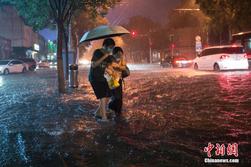 People wade through water on an inundated street in Beijing, on Aug 9, 2020. (PHOTO / CHINA NEWS AGENCY)
People wade through water on an inundated street in Beijing, on Aug 9, 2020. (PHOTO / CHINA NEWS AGENCY)
A vast stretch of areas in northern China are expected to be frequented by brief but heavy rainfall in the coming week amid a flood control situation that is forecast to be grim, according to flood control authorities.
As rainfall in the south are mostly abating this week, a bout of thunderstorms has begun to lash many areas in the north.
As rainfall in the south are mostly abating this week, a bout of thunderstorms has begun to lash many areas in the north
"Most areas in northern China are expected to be engulfed by precipitation frequently this week," National Meteorological Center said in a release on Monday.
The affected areas will receive precipitation of 100 to 200 millimeters on both Tuesday and Wednesday, it said.
READ MORE: North China about to get its turn with heavy rains
The round of precipitation will feature severe convective weather, which is characterized by strong winds, hail, thunderstorms and brief but heavy rainfall. Some areas in North and Northeast China will be battered by rainstorms accompanied by thunder and gust, it said.
On Monday, the National Meteorological Center issued a blue alert for severe convective weather, the lowest in the country's four-tier color-coded weather warning system, warning that 20 provincial regions, mostly in the north, will be stricken by intense weather in the 24 hours starting from 2 pm on Monday.
ALSO READ: North China to get relief from heat soon
Generally, the hourly precipitation in these regions, including Gansu and Shaanxi provinces and Beijing, is forecast to be 20 to 50 millimeters. In the most extreme circumstance, however, it will exceed 70 millimeters, about one-eighth of the average annual precipitation in the capital, it said.
It said the weather will occur mostly from noon to midnight.
The coming rainfall may unfold a grim flood control situation in the north as authorities forecast, and many regions have rolled out enhanced precautionary measures.
Affected by the rainfall, major floods may hit the Songhua and Liaohe rivers, southern parts of Haihe River and the middle reaches of the Yellow River, according to the Ministry of Water Resources.
In May, water resources bureaus across Hebei province removed 476,400 cubic meters of garbage and demolished illegal buildings of 506,000 square meters in 1,386 water courses, according to the Hebei Provincial Water Resources Department.
Zhai Wang, who heads the water resources inspection team in Chengde county in the province, said the county has demolished all 84 illegal buildings built in watercourses of the county's 25 rivers, most of which are only streams in the rainy season.
Some of the buildings were built up to two decades ago, before the government set demarcation lines for watercourses, and most didn't get government approval. Owners without approval will not be compensated, he said, adding that the buildings pose great hazards to people's safety and wealth.
"Floods in the county usually will not result in big losses to people's lives and wealth unless there are buildings in the watercourses," he said.
In Shandong, local food control authorities have enhanced hydrologic monitoring and ramped up operation of major reservoirs as the province draws a lesson from the flood in Shouguang city, the country's major vegetable producer.
Unprecedented flooding triggered by incessant rain brought by Typhoon Rumbia and a last-minute discharge of floodwaters from upstream reservoirs left 106,700 greenhouses in the city inundated and damaged in August 2018, which triggered soaring prices of vegetables nationwide.
Over 200 high-definition cameras have been set up in major reservoirs across the province to help authorities learn about the conditions of these water bodies. The province has also added another 211 hydrological stations to some 11,000 existing ones as it makes efforts to ratchet up monitoring and forecasting capabilities, said Yu Jing, deputy head of flood and drought prevention at the Shandong Provincial Water Resources Department.
"We have established a coordination mechanism in the province," she said. "Once major floods occur in a river basin, the provincial water resources department will head the coordination and operation of major reservoirs and sluice gates in the entire basin."
The operation information of major water conservancy projects will be shared with relevant areas in real time, she added.


